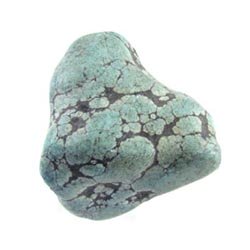Sign up for Lesson Plans, discounts & more!
Turquoise

Turquoise is a stone that has been valued by humans for thousands of years. Native Americans appreciated this stone for its natural beauty and for its mythical power. It was used in ancient Egypt at least 3000 years ago. Important buildings in middle eastern cultures had domes and walls covered with turquoise. The Chinese, Greeks, Indians, and Turks all prized this pale blue stone.
Turquoise Formation
Turquoise is formed as a secondary mineral. This means that the minerals (copper, phosphate, and aluminum) that make up the turquoise were part of another mineral or group of minerals before they came together in this form. It is found in arid climates often forming in cavities of volcanic rocks.
Classed as a phosphate the chemical formula is CuAl6(PO4)4(OH)8 4H2O a hydrous phosphate of copper and Aluminum. This cryptocrystalline mineral is relatively soft compared to other precious stones about 5-7 on the Mohs scale. The best stones for jewelry and other decorative objects are those on the harder end of the scale. Turquoise has a wide range of shades through the blues and greens.
Notable deposits of turquoise are found in Iran, Sinai, and the southwestern part of the United States.
Streak: bluish white
Luster: waxy to subvitreous
Transparency: opaque
Crystal system: triclinic
Crystal Habits: massive, nodular
Specific Gravity: About 2.6 - 2.9 depending on the specimen
Hardness (Mohs): 5 to 7
Cleavage: usually n/a
Fracture: conchoidal
Uses: Mineral Specimens, jewelry and ornamentals
Associated Minerals: copper
Location: Iran, Sinai, and the southwestern part of the United States.

INTERESTED IN MORE? IF SO, YOU MAY WANT TO CHECK OUT OUR OTHER SITES:
fossilicious.com - Our online fossil and mineral rock shop.
fossils-facts-and-finds.com - An educational site about fossils.











